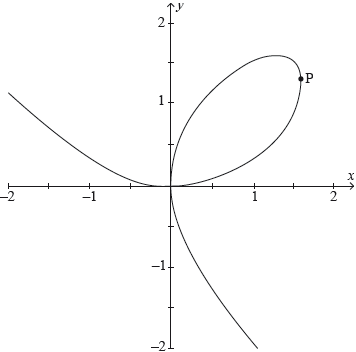| Date | May 2021 | Marks available | 1 | Reference code | 21M.3.AHL.TZ1.1 |
| Level | Additional Higher Level | Paper | Paper 3 | Time zone | Time zone 1 |
| Command term | Write down | Question number | 1 | Adapted from | N/A |
Question
This question asks you to explore the behaviour and key features of cubic polynomials of the form .
Consider the function for and where is a parameter, .
The graphs of for and are shown in the following diagrams.
On separate axes, sketch the graph of showing the value of the -intercept and the coordinates of any points with zero gradient, for
Hence, or otherwise, find the set of values of such that the graph of has
Given that the graph of has one local maximum point and one local minimum point, show that
Hence, for , find the set of values of such that the graph of has
.
.
Write down an expression for .
a point of inflexion with zero gradient.
one local maximum point and one local minimum point.
no points where the gradient is equal to zero.
the -coordinate of the local maximum point is .
the -coordinate of the local minimum point is .
exactly one -axis intercept.
exactly two -axis intercepts.
exactly three -axis intercepts.
Consider the function for and where .
Find all conditions on and such that the graph of has exactly one -axis intercept, explaining your reasoning.
Markscheme
: positive cubic with correct -intercept labelled A1
local maximum point correctly labelled A1
local minimum point correctly labelled A1
[3 marks]
: positive cubic with correct -intercept labelled A1
local maximum point correctly labelled A1
local minimum point correctly labelled A1
Note: Accept the following exact answers:
Local maximum point coordinates .
Local minimum point coordinates .
[3 marks]
A1
Note: Accept (an expression).
[1 mark]
A1
[1 mark]
considers the number of solutions to their (M1)
A1
[2 marks]
A1
Note: The (M1) in part (c)(ii) can be awarded for work shown in either (ii) or (iii).
[1 mark]
attempts to solve their for (M1)
(A1)
Note: Award (A1) if either or is subsequently considered.
Award the above (M1)(A1) if this work is seen in part (c).
correctly evaluates A1
the -coordinate of the local maximum point is AG
[3 marks]
correctly evaluates A1
the -coordinate of the local minimum point is AG
[1 mark]
the graph of will have one -axis intercept if
EITHER
(or equivalent reasoning) R1
OR
the minimum point is above the -axis R1
Note: Award R1 for a rigorous approach that does not (only) refer to sketched graphs.
THEN
A1
Note: Condone . The A1 is independent of the R1.
[2 marks]
the graph of will have two -axis intercepts if
EITHER
(or equivalent reasoning) (M1)
OR
evidence from the graph in part(a)(i) (M1)
THEN
A1
[2 marks]
the graph of will have three -axis intercepts if
EITHER
(or equivalent reasoning) (M1)
OR
reasoning from the results in both parts (e)(i) and (e)(ii) (M1)
THEN
A1
[2 marks]
case 1:
(independent of the value of ) A1
EITHER
does not have two solutions (has no solutions or solution) R1
OR
for R1
OR
the graph of has no local maximum or local minimum points, hence any vertical translation of this graph () will also have no local maximum or local minimum points R1
THEN
therefore there is only one -axis intercept AG
Note: Award at most A0R1 if only is considered.
case 2
is a local maximum point and is a local minimum point (A1)
Note: Award (A1) for a correct -coordinate seen for either the maximum or the minimum.
considers the positions of the local maximum point and/or the local minimum point (M1)
EITHER
considers both points above the -axis or both points below the -axis
OR
considers either the local minimum point only above the -axis OR the local maximum point only below the -axis
THEN
(both points above the -axis) A1
(both points above the -axis) A1
Note: Award at most (A1)(M1)A0A0 for case 2 if is not clearly stated.
[6 marks]


